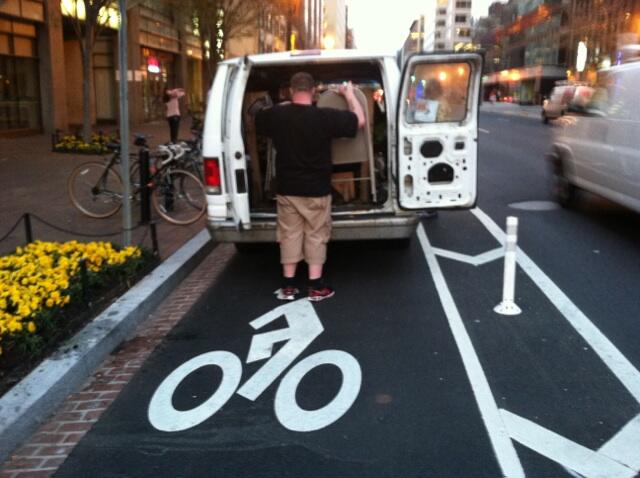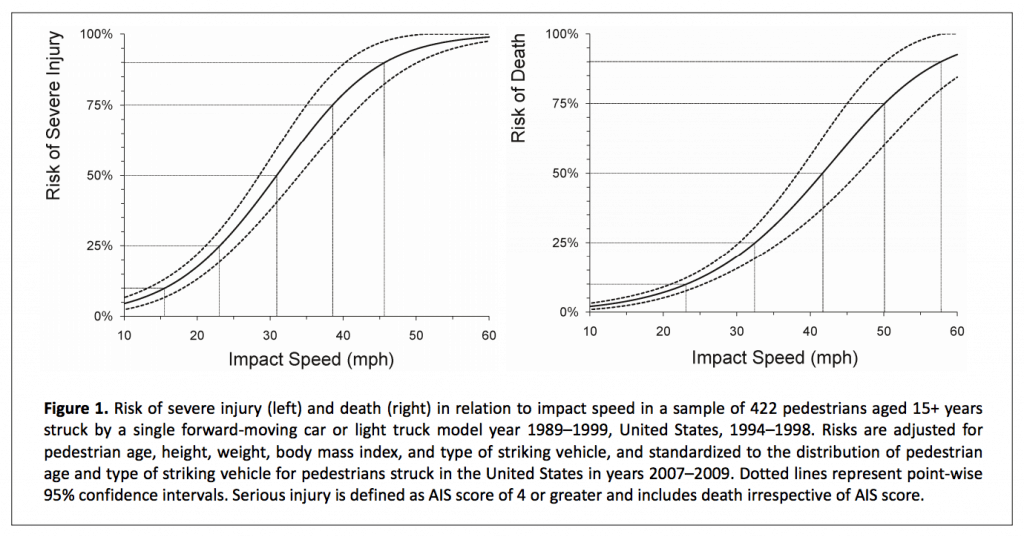Why not park in the bike lane? You probably won’t get a ticket.

Why? Because it’s easy to get away with it.
Bike lane parking enforcement is perfunctory at best:
If you’ve ever come across a blocked bike lane while riding, you understand instinctively why it’s not safe. You’re forced to exit the bike lane into a lane of (often) fast moving traffic. It’s an abrupt, unexpected transition from a lower stress riding situation to a high stress one. Of the 723,237 parking tickets issued in this 5 month period, only 2,420 were for parking in bike lanes. That’s about 3 out of every 1,000 tickets. That comes to about 16 tickets per day, spread over more than 70 miles of bike lanes, or one ticket per day for every 4.5 miles of bike lane. For some handy context: 4.5 miles is the length of the 14th Street bike lane that extends (with a few notorious gaps) from Thomas Circle to Aspen Street NW at the old Walter Reed Center. Or a complete loop down the lengths of the Q and R Street NW bike lanes. If you’ve ridden any portion of those bike lanes recently, you’ll understand the scope of the enforcement failure here. In about half an hour, you could ride either stretch just once and encounter a dozen places where the bike lane has been blocked by a delivery truck, a cab or ridesharing vehicle, or just a driver too impatient to find a proper parking space. Heck, on 17 days so far this year, there were ZERO bike lane parking tickets issued. We find it difficult to believe that there were 17 days without a single car parked in a bike lane. A key tenet of the District’s Vision Zero Action Plan is that agencies should prioritize safety over convenience. In general, this enforcement data demonstrates a pervasive failure to do so. For example: combined tickets for blocking a bike lane, blocking a fire hydrant or a bus stop, all of which put people in actual danger, numbered just over 20,000 or 2.8% of total tickets. The District issued three times as many (more than 60,000) tickets for residential parking permit violations, which are important but ultimately a matter of convenience rather than safety.Traffic safety on neighborhood streets is also barely enforced:
When we looked at moving violation data, we found another distressing data point: MPD issued 331,388 speeding tickets during this period. Of those, only 9 (yes, a single digit) were for speeding less than 11mph over the speed limit. On residential streets, this is functionally a 40% increase in the speed limit. Those 10mph are not trivial—research shows that in a crash, the risk of death or serious injury for vulnerable road users doubles when driver speeds increase from 25 to 35 mph. Too often we hear the claim that speeding is a victimless crime and that everyone does it. But every year we see the tragic consequences of driving too fast. Since 2012, more than 40% of traffic deaths in DC have been related to speeding, according to NHTSA. These tragedies are preventable, but prevention must start with law enforcement decision makers taking the threat seriously.
Too often we hear the claim that speeding is a victimless crime and that everyone does it. But every year we see the tragic consequences of driving too fast. Since 2012, more than 40% of traffic deaths in DC have been related to speeding, according to NHTSA. These tragedies are preventable, but prevention must start with law enforcement decision makers taking the threat seriously.
Takeaway: Drivers break the law because they can get away with it.
Transportation officials often tout what they refer to as the “Three Es”— Engineering, Education, and Enforcement— when they talk about how to build a safe road culture. Here’s the thing: those “E’s” only work if they’re sending the same message. If there’s nothing but a strip of paint on the road to prevent you from parking your car in a place that’s supposed to be reserved for bikes, and if you’ve never gotten a ticket for parking in the bike lane before (and you don’t even know anyone who’s gotten a ticket for it), then a few inscrutable bus shelter ads are not going to keep you from parking in the bike lane.A robust and fully implemented Vision Zero program is how we fix this.
Vision Zero makes it everyone’s job—from policymakers to traffic engineers to law enforcement officials—to completely prevent traffic deaths and serious injuries. This is what Mayor Bowser has committed to accomplishing by 2024 in DC. This data demonstrates that it’s going to require some seismic priority shifts from several agencies to achieve this goal. Luckily, some good changes are already happening. The data that we’re looking at right now wasn’t even publicly available a few years ago—it has been made available as part of the Vision Zero program. We look forward to seeing how DDOT, MPD, the Department of Public Works (which operates parking enforcement), the Department of Motor Vehicles, and others will use all this data to make decisions about how to allocate their resources in ways that end traffic violence.Get involved! Want email action alerts on Vision Zero? Yes!
You must be logged in to post a comment.